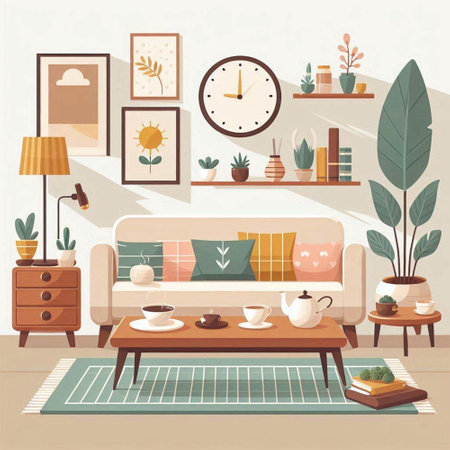Introduction to Professional Associations in UK Interior Design
In the United Kingdom, professional associations play a pivotal role in shaping the interior design industry. These organisations provide structure, guidance, and credibility for practitioners at all career stages. Among the most prominent is the British Institute of Interior Design (BIID), which stands as a benchmark of professional standards and ethical practice. The BIID, alongside other significant bodies, works tirelessly to establish best practices, promote continuous professional development, and advocate for the interests of interior designers nationwide. By setting clear criteria for membership and accreditation, these associations help ensure that clients and the wider public can trust the expertise and integrity of accredited professionals. As a result, belonging to such an organisation is often seen not just as a mark of achievement but also as a commitment to ongoing learning and excellence within the UK’s dynamic design landscape.
2. Understanding Accreditation in the UK Context
Accreditation within the UK interior design industry is a critical process that ensures practitioners and organisations meet established standards of competence, professionalism, and ethical practice. It is important to distinguish accreditation from both qualifications and professional memberships, as these terms are often mistakenly used interchangeably.
Accreditation vs Qualification vs Membership
| Aspect | Accreditation | Qualification | Membership |
|---|---|---|---|
| Definition | Formal recognition by an authoritative body that a person or organisation meets specific standards | An academic or vocational achievement awarded after completing a course or training | Affiliation with a professional association, often requiring adherence to a code of conduct |
| Purpose | Assure clients and employers of professional competence and quality standards | Demonstrate knowledge and skills in a subject area | Provide access to resources, networking, and continuous development opportunities |
| Examples in Interior Design | SBID Accredited Designer, BIID Registered Interior Designer® | Bachelor’s or Master’s Degree in Interior Design, City & Guilds Diploma | Member of SBID, BIID, or Chartered Society of Designers (CSD) |
| Assessment Process | Rigorous evaluation including portfolio review, interviews, and ongoing CPD requirements | Coursework, exams, practical assessments during education or training programmes | Submission of application and evidence of experience or qualification; adherence to codes of conduct |
| Status Conferred | Professional status recognised by clients and industry peers; right to use titles such as ‘Accredited’ or ‘Registered’ Designer | Awarded certificate/diploma/degree but not necessarily permission to practise independently as a professional designer | Able to participate in association activities and use membership post-nominals (e.g., SBID Member) |
The Accreditation Process in Practice
The UK’s main professional bodies for interior design—such as the British Institute of Interior Design (BIID) and the Society of British & International Interior Design (SBID)—each have their own accreditation frameworks. Typically, candidates must demonstrate substantial experience in the field, submit detailed portfolios showcasing their project work, provide references from clients or peers, and undergo assessment interviews. Maintaining accreditation often requires ongoing Continuing Professional Development (CPD), ensuring that accredited designers remain up-to-date with regulations, trends, and best practices.
The Importance of Standards
These accreditation standards are shaped by both national guidelines and international benchmarks. They address not only technical competencies but also ethical practice, client communication, health and safety awareness, and sustainability considerations. As such, accreditation serves as an assurance mark for both clients seeking reliable professionals and designers wishing to differentiate themselves in a competitive market.

3. Benefits of Membership and Accreditation for Practitioners
Membership in a recognised professional association and achieving accreditation offer substantial advantages to interior design practitioners across the UK. First and foremost, professional recognition acts as a mark of credibility, demonstrating that a designer adheres to established standards and ethical codes. This not only instils confidence in clients but also distinguishes members from non-accredited competitors in an increasingly crowded market.
Networking opportunities form another critical benefit. Professional associations regularly host events, seminars, and workshops that enable designers to connect with peers, suppliers, and potential collaborators. These interactions often lead to valuable partnerships, referrals, and insights into industry trends—elements vital for staying relevant and competitive within the UK context.
The emphasis on continuous professional development (CPD) is particularly notable in the British interior design sector. Accreditation typically requires ongoing education through CPD courses, lectures, or hands-on workshops. Engaging in CPD ensures practitioners remain up-to-date with evolving regulations, sustainability practices, and technological advances affecting interior spaces. This commitment to learning not only boosts individual competency but also contributes to the overall professionalism and reputation of the UK interior design community.
Together, these aspects—recognition, networking, and continuous development—significantly support career progression. They open doors to higher-profile projects, leadership roles within firms or associations, and even influence over industry standards. For emerging designers and seasoned professionals alike, membership and accreditation are not mere formalities but strategic investments in long-term success.
4. Impact on Clients and End Users
When discussing the role of professional associations and accreditation in the UK interior design industry, it is essential to examine their direct influence on clients and end users. Accreditation not only sets a benchmark for professional standards but also fosters trust, improves quality assurance, and shapes public perception. These factors collectively enhance the client experience and contribute to more successful project outcomes.
Client Trust: Building Confidence through Accreditation
Clients seeking interior design services often face a complex marketplace with varying levels of expertise and professionalism. Accredited designers—those recognised by bodies such as the British Institute of Interior Design (BIID) or the Society of British & International Design (SBID)—signal a commitment to rigorous standards and ongoing professional development. This affiliation assures clients that their chosen designer adheres to ethical practices, complies with health and safety regulations, and maintains up-to-date industry knowledge.
Quality Assurance: Ensuring Consistency and Standards
Accreditation provides a framework for consistency across the industry, offering reassurance regarding the quality of service delivered. Accredited professionals are typically required to follow established codes of conduct, maintain insurance, and engage in continuous learning. For clients, this means reduced risk of substandard work or legal complications. The table below illustrates key differences in client experience between accredited and non-accredited interior designers:
| Aspect | Accredited Designer | Non-Accredited Designer |
|---|---|---|
| Professional Standards | Adheres to formal codes of conduct | No enforced standards |
| Insurance Coverage | Typically holds professional indemnity insurance | May lack comprehensive insurance |
| Continuous Professional Development | Mandatory CPD requirements | No formal CPD structure |
| Dispute Resolution Mechanism | Access to association-led mediation | No guaranteed mechanism available |
| Public Recognition | Higher perceived credibility | Lower general awareness or trust |
Public Perception: Shaping Industry Reputation
The presence of recognised professional associations and accreditation mechanisms contributes positively to how the public views the interior design profession in the UK. When clients encounter accredited designers, they are more likely to associate the service with quality, reliability, and ethical practice—differentiating these professionals from unaccredited individuals or hobbyists. Over time, this elevates overall industry standards and increases demand for qualified designers.
The Knock-On Effect for End Users
The benefits of accreditation extend beyond initial clients to end users—those who ultimately inhabit or use the designed spaces. Accredited designers consider not only aesthetics but also functionality, safety, accessibility, and sustainability in line with best practices promoted by professional bodies. This holistic approach results in environments that are more comfortable, user-friendly, and future-proofed for changing needs.
Conclusion: An Informed Choice for Clients and Communities
The role of professional associations and accreditation is integral in ensuring that clients receive reliable guidance, high-quality outcomes, and peace of mind throughout their projects. By fostering trust and accountability, these mechanisms help align client expectations with industry capabilities—ultimately benefiting both individual users and wider society.
5. Challenges and Critiques within the Industry
The role of professional associations and accreditation in the UK interior design industry is not without its share of challenges and critical perspectives. While these bodies aim to elevate standards, provide legitimacy, and foster a sense of community among practitioners, several criticisms have emerged over time that warrant open discussion.
Barriers to Entry
One prominent concern relates to barriers to entry for aspiring designers. Professional associations often require membership fees, completion of accredited courses, or a demonstrable portfolio—criteria that can be financially or practically prohibitive for some talented individuals. The cost and time commitment involved in achieving accreditation may inadvertently favour those with greater resources or existing industry connections, potentially stifling diversity and innovation within the sector.
Lack of Unified Standards
Another critique centres on the absence of universally accepted standards across different associations. Unlike some professions regulated by law, interior design in the UK remains largely self-regulated. This can create confusion for clients and practitioners alike regarding what constitutes a “qualified” designer, especially when multiple associations offer competing credentials.
Perceived Elitism and Accessibility
Certain voices within the industry argue that some professional bodies risk fostering a culture of elitism. There are perceptions that these organisations prioritise established practices or well-connected firms, making it harder for emerging designers or those from non-traditional backgrounds to gain recognition. Furthermore, regional disparities in access to accredited training—particularly outside London and major cities—can further exacerbate inequality.
Areas for Improvement
For professional associations to remain relevant and beneficial, ongoing reflection and adaptation are essential. Suggestions include offering more accessible pathways to accreditation, increasing transparency around assessment criteria, and actively promoting inclusivity. By addressing these critiques head-on, the UK interior design industry can ensure its professional bodies truly serve the needs of all members and continue to raise the bar for excellence.
6. The Future of Professional Standards in UK Interior Design
Looking ahead, the UK interior design industry stands at a crossroads shaped by rapid technological advancements, growing client expectations, and an increasing emphasis on sustainability and inclusivity. Professional associations and accreditation bodies are not immune to these shifts; rather, they are expected to play an ever more dynamic role in guiding practitioners through change. The evolution of professional standards is likely to include a stronger focus on digital competencies, such as proficiency with BIM (Building Information Modelling) and virtual reality tools, which are becoming central to contemporary design practices.
Furthermore, potential reforms could see accreditation frameworks updated to reflect new legislative requirements—particularly around environmental responsibility and accessibility. As the government continues to push for greener building practices and universal design, associations like the British Institute of Interior Design (BIID) may well take the lead in setting benchmarks that exceed minimum statutory obligations.
Another emerging trend is the call for greater transparency and consumer protection within the profession. Clients increasingly expect clear evidence of competence, ethical conduct, and ongoing professional development from their designers. In response, professional bodies are likely to refine their codes of practice and strengthen disciplinary procedures to maintain public trust in the industry.
There is also a noticeable shift towards globalisation within interior design, with UK professionals frequently collaborating with international partners or working on overseas projects. Accreditation schemes may need to adapt by recognising foreign qualifications or establishing reciprocal arrangements with counterpart organisations abroad, ensuring that UK designers remain competitive on the world stage.
Ultimately, the future role of professional associations will involve balancing tradition with innovation—preserving core values of professionalism and integrity while proactively embracing change. By continually updating accreditation processes, fostering collaboration across disciplines, and championing lifelong learning, these bodies will help ensure that UK interior designers are well-equipped to meet the demands of a fast-evolving market.


